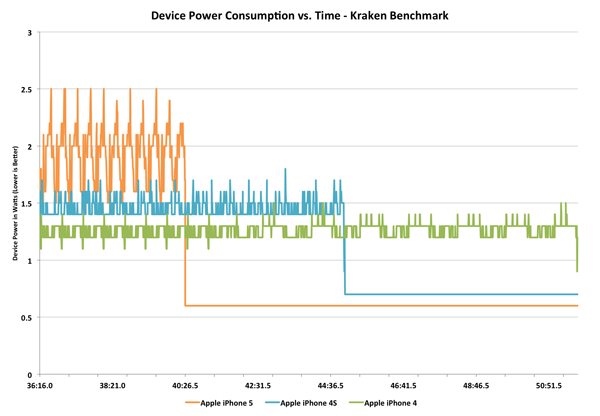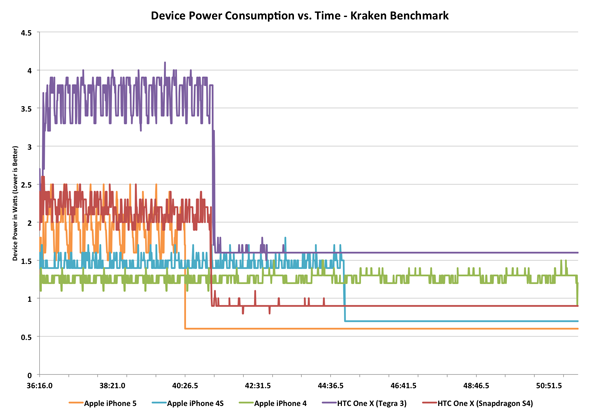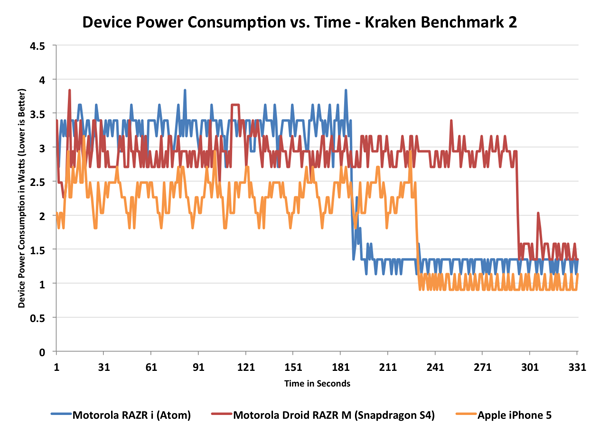The iPhone 5 Review
by Anand Lal Shimpi, Brian Klug & Vivek Gowri on October 16, 2012 11:33 AM EST- Posted in
- Smartphones
- Apple
- Mobile
- iPhone 5
Increased Dynamic Range: Understanding the Power Profile of Modern SoCs
Section by Anand Shimpi
The iPhone 4S greatly complicated the matter of smartphone power consumption. With the A5 SoC Apple introduced a much wider dynamic range of power consumption to the iPhone than we were previously used to. Depending on the workload, the A5 SoC could either use much more power than its predecessor or enjoy decreased overall energy usage. I began our battery life analysis last time with some graphs showing the power savings realized by a more power hungry, faster CPU.
The iPhone 5 doesn't simplify things any more. I believe the days of us having straightforward discussions about better/worse battery life are long gone. We are now firmly in the era of expanded dynamic range when it comes to smartphone power consumption. What do I mean by that? The best way to explain is to look at some data. The graphs below show total device power consumption over time for a handful of devices running the Mozilla Kraken javascript benchmark. Kraken is multithreaded and hits the CPU cores fairly well. The power profile of the benchmark ends up being very similar to loading a very js-heavy web page, although for a longer period of time. All of the device displays were calibrated to 200 nits, although obviously larger displays can consume more power.
Let's start out by just looking at the three most recent iPhone generations:
The timescale for this chart is just how long the iPhone 4 takes to complete the Kraken benchmark. The iPhone 4/4S performance gap feels a lot bigger now going back to the 4 than it did when the 4S launched, but that's how it usually seems to work. Note how tight the swings are between min and max power consumption on the iPhone 4 during the test. As a standalone device you might view the iPhone 4 as being fairly variable when it comes to power consumption but compared to the 4S and 5 it might as well be a straight line.
The 4S complicated things by consuming tangibly more power under load than the 4, but being fast enough to complete tasks in appreciably less time. In the case of this Kraken run, the 4S consumes more power than the 4, however it's able to go to sleep quicker than the 4 and thus draw less power. If we extended the timeline for the iPhone 4 significantly beyond the end of its benchmark run we'd see the 4S eventually come out ahead in battery life as it was able to race to sleep quicker. The reality is that with more performance comes increased device usage - in other words, it's highly unlikely that with a 50% gain in performance users are simply going to continue to use their smartphone the same way as they would a slower device. Usage (and thus workload) doesn't remain constant, it's somewhat related to response time.
The iPhone 5 brings new meaning to device level power consumption. With a larger display and much more powerful CPU, it can easily draw 33% more power than the 4S under load, on average. Note the big swings in power consumption during the test. The A6 SoC appears to be more aggressive in transitioning down to idle states than any previous Apple SoC, which makes sense given how much higher its peak power consumption can be. Looking at total energy consumed however, the iPhone 5 clearly has the ability to be more power efficient on battery. The 5 drops down to iPhone 4 levels of idle power consumption in roughly half the time of the iPhone 4S. Given the same workload that doesn't run indefinitely (or nearly indefinitely), the iPhone 5 will outlast the iPhone 4S on a single charge. Keep the device pegged however and it will die quicker.
Out of curiosity I wanted to toss in a couple of other devices based on NVIDIA and Qualcomm silicon to see how things change. I grabbed both versions of the HTC One X:
The Tegra 3 based One X actually performs very well in this test, but its peak power consumption is significantly worse than everything else. It makes sense given the many ARM Cortex A9 cores built on a 40nm G process running at high clock speeds on the Tegra 3.
The 28nm Snapdragon S4 (dual-core Krait) based One X gives us some very interesting results. Peak power consumption looks identical to the iPhone 5, however Apple is able to go into deeper sleep states than HTC can with its S4 platform. Performance is a little worse here but that could be a combination of SoC and software/browser. I used Chrome for all of the tests so it should be putting Android's best foot forward, but the latest update to Safari in iOS 6 really did boost javascript performance to almost untouchable levels.
At the end of the day, the power profile of the iPhone 5 appears to be very close to that of a modern Snapdragon S4 based Android smartphone. Any battery life gains that Apple sees are strictly as a result of software optimizations that lead to better performance or the ability to push aggressively to lower idle power states (or both). It shouldn't be very surprising that these sound like a lot of the same advantages Apple has when talking about Mac battery life as well. Don't let the CPU cores go to sleep and Apple behaves similarly to other device vendors, but it's really in idle time or periods of lighter usage that Apple is able to make up a lot of ground.
There's one member of the modern mobile SoC market that we haven't looked at thus far: Intel's Medfield. The data below isn't directly comparable to the data above, my measurement methods were a little different but the idea is similar - we're looking at device level power consumption over time while Kraken runs. Here I'm only focusing on the latest and greatest, the Atom based Motorola RAZR i, the Snapdragon S4 based Droid RAZR M and the iPhone 5. The RAZR i/M are nearly identical devices making this the perfect power profile comparison of Atom vs. Snapdragon S4. The RAZR i is also the first Atom Z2460 based part to turbo up to 2.0GHz.
Very interesting. Atom is the only CPU that can complete the Kraken benchmark in less time than Apple's Swift. Peak power consumption is definitely higher than both the Qualcomm and Apple devices, although Intel's philosophy is likely that the added power usage is worth it given the quicker transition to idle. Note that Atom is able to drive to a slightly lower idle level than the Snapdragon S4, although the Swift based iPhone 5 can still go lower.
At least based on this data, it looks like Intel is the closest to offering a real competitor to Apple's own platform from a power efficiency standpoint. We're a couple quarters away from seeing the next generation of mobile SoCs so anything can happen next round, but I can't stress enough that the x86 power myth has been busted at this point.
I will add that despite Intel's performance advantage here, I'm not sure it justifies the additional peak power consumption. The RAZR i ends up being faster than the iPhone 5 but it draws substantially more power in doing so, and the time savings may not necessarily offset that. We'll see what happens when we get to our battery life tests.













276 Comments
View All Comments
KPOM - Wednesday, October 17, 2012 - link
However, Apple made a point about anodizing in its display. Also, Apple has historically placed a premium value on industrial design so it is interesting to read more specifics. What has struck me about Apple is how much time they devote to things people don't notice consciously or will never see on a spec sheet, but which can unconsciously affect the user experience. The aluminum has a nice feel to it, and I can see why Apple would forgo putting a resin coating on it, even though it would make it less susceptible to scratching. Understanding the physics helps make clear what kind of compromises Apple needs to make.phillyry - Sunday, October 21, 2012 - link
As per emotional input:I actually look for this in the review and podcasts because it colours the facts.
While I find the facts to be interesting and a good way to pass the time, at the end of the day my purchase decision, like those of human beings in general, will be largely guided by the sentiment of the matter.
People want to know how happy others are with their devices. Just facts alone lack humanity. I personally love hearing opinions, side comments and anecdotes that give me insight into the thoughts, feelings and experiences of people who's opinions I hold in high regard, such as anand and the gang.
There's something to be said for the qualitative experience that comes with the daily use of the device as your primary 'phone'.
Many others may also be looking to hear the comradery, jest, and fun-casual tone that you can get on this site when these guys just let their opinions out or go off on technical tangents. If you listen to the podcasts it'll all make more sense.
phillyry - Sunday, October 21, 2012 - link
P.S. the feeling that someone else, like anand, has about the device is also important because, if you are considering buying one of these things than you're going to have it for a couple of years and won't want to feel stuck with it.Spunjji - Friday, October 19, 2012 - link
I have to agree here... I already know how anodizing works (not specialist knowledge, we were taught in high-school...) and even if I didn't, I'm not sure a 'phone review is the best place to learn. An outside link would have sufficed. The whole thing does basically say that Apple had no choice in the matter unless they change the design, and that's really the point there. They should have changed the bloody design.arghhh - Tuesday, October 16, 2012 - link
How is it as a phone? Iphone never has been good at its primary function (I take an old clamshell over most smartphones in that regard).Arbee - Tuesday, October 16, 2012 - link
Brian Klug covered voice quality in this writeup, and AT's previous iOS 6 review covered the new voice call features. The upshot is it's at least as good as any other smartphone, even if no cellphone can replace a hardwired slab of mid-60s AT&T bakelite :)manik. - Tuesday, October 16, 2012 - link
Awesome read.Tangey - Tuesday, October 16, 2012 - link
The gpu comparison table shows the new iPad running @200mhz, it actually runs @250mhz ( as did the gpu in the ipad2). In a previous article you used this incorrect 200mhz as a reference point to determine that the iphone5 was running its gpu @266mhz.My calculations based on the iphone5's performance relative to the ipad3 @ 250mhz, indicate to me that the 543mp3 in the iphone5 is running in excess of 300mhz, most likely 325mhz, which also happens to be an exact divider of the 1.3ghz clock of the CPUs.
DustoMan - Tuesday, October 16, 2012 - link
Have you ever looked into why phones from certain manufactures are so picky about their chargers? I've had phones from HTC, Motorola, and Samsung and I've had three wildly different experiences when it comes to what chargers will work in what devices. When I had an HTC Incredible, I could stick pretty much anything I wanted to it and it would charge. If the charger didn't have much current, it would charge slower than a charger with my current. My Galaxy Nexus would work with a few of my chargers, but the oddest thing would happen when I would try connecting it to a Griffin car adapter that had the 1.5A plug necessary to charge a first gen iPad. The only plug that would charge it consistently was a car adapter that I purchased that was branded Samsung. Even an adapter that Verizon sold me as being compatible wouldn't work. Finally the worst offender is my wife's Droid 2 Global. It will only charge with a Motorola adapter. Adapters that work with my Galaxy Nexus, which you would think would need chargers with a higher current, wouldn't work. To charge her phone on my PowerMat, I have to plug the phone into a reserve battery and then use the Powermat to charge that reserve battery while it's charging her phone. Stupid huh?zephxiii - Tuesday, October 16, 2012 - link
Yes i recall Motorola's earlier microUSB equipped phones to be very picky....especially if the battery went completely flat as it seemed like only Motorola chargers (or compatible) would breathe life back into them.